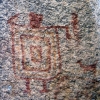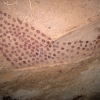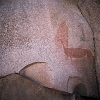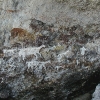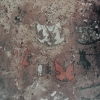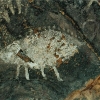Pictographs, also called rock paintings, are drawings made either on slabs of rocky outcrops or on isolated blocks and, unlike petroglyphs, are produced by applying colored material to the rock. Although the best-preserved pictographs are found in rock shelters and caves where they have been protected from the elements, in general the preservation of this kind of rock art depends on the quality of the pigments and thickeners that were used to create them. These pigments were usually made from manganese or coal (for black images), iron oxides (for reds and yellows), copper oxides (for greens and blues), and different blends or mixtures of calcium or magnesium (for white) image 5. Image 4. As the raw material needed was not always available on site, there seems to have been a lively trade and exchange in these substances throughout the prehistoric period. Ochre was one of the most highly valued pigments. This iron oxide comes in a variety of colors that range from pale yellow to dark reddish brown, and all red shades in between image 1. The simplest pictographs, however, were made with mud or drawn with pieces of charcoal.
To make the pigments the painters had to grind the raw material, which could be of animal, vegetable or mineral origin. They then mixed this ground material with a liquid to form a smooth paste that could be applied easily onto the rock. Thickeners could include albumin (from eggs), oil, fat, plant sap, blood, saliva, urine, and even water. The mixture was applied directly onto the rock with fingers image 2 or using an instrument such as a feather, twig, bone shard or a bunch of animal hair formed into a swab or brush imagen 3. The rock surface may have had to be moistened first before the paint was applied.
Stencils were a special kind of pictograph and were made by spitting or blowing pigment through a tube and onto an object placed against the rock, producing an outline of the object imagen 6. Another rather common technique involved covering the object with the pigment paste and stamping it onto the rock to produce a silhouette. The negative and positive imprints of hands so frequently seen in rock art the world over were produced using these two techniques. The “Cueva de las Manos” (Cave of the Hands) in Patagonia holds some of the best examples of this type of rock painting on the American continent.





































